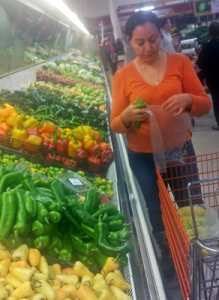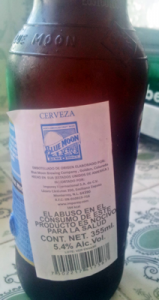Mexico Grocery Shopping
- Last Updated: April 18, 2023 by Al Barrus
- Categories:
- Food, Living in Mexico, Shopping
 I often comment on blogs about how much cheaper things are south of the border. I'm mostly referring to things that are labor-related. For example, a haircut in Saltillo, in the northeast region of Mexico, usually costs 50 pesos, or about four bucks, and no tip is expected.
I often comment on blogs about how much cheaper things are south of the border. I'm mostly referring to things that are labor-related. For example, a haircut in Saltillo, in the northeast region of Mexico, usually costs 50 pesos, or about four bucks, and no tip is expected.
I'm told that prices drop even more the further south you go: the further away from the US border you get, the cheaper the prices for labor and goods. Since the US is Mexico's number-one trading partner, the riches seemingly trickle down from the border, and wages tend to be higher in the northern regions of Mexico. If you're in a tourist trap area, like the Cancun hotel strip, you may want to get out of the foreigner/tourist zone, to where real Mexicans live and shop, if you are looking for the best bargains.
If you're staying in Mexico for an extended period of time, you may want to do some home cooking. Even if it's not a gourmet preparation, you may at least want to save a bit of money on restaurants and buy some cereal and milk for breakfast and late-night snacking.
Milk isn't one of those things that are cheaper in Mexico. A gallon costs about four dollars American, or 50 pesos, at the grocery stores in Saltillo. I've found that buying imported milk from the US at the San Antonio-based grocer HEB, is a few pesos cheaper and usually has a longer shelf-life. HEB is usually only found in cities close to the Texas border. Mexico's number one private employer, Wal-Mart, also stocks American brands, but is generally regarded as a more expensive retailer.
Apples are grown in the cooler elevated climates in the mountain towns not far from where I live, but most big grocers, even the Mexican national chain Soriana, tend to stock more apples that have the USA/Washington sticker. I'd conjecture that my home state's apples are stocked more because they have been engineered and treated to have a longer shelf-lives and the farms produce higher crop yields. Ironically, the folks who tend to pick the apples in Washington are foreign workers from Latin America.
Generally speaking, most foods in Mexico are less expensive and grown organically. There are more hands-on farming practices since mechanized, highly engineered agriculture isn't as developed in Mexico as it is in the US. Many educated Mexicans I've spoken with speculate that the hormones used in American beef and dairy to produce higher yields affects the gringo population negatively, however Mexico has problems of its own.
Americans who are in Mexico for the long term, often find ourselves seeking out rare foodstuffs that are hard to come by because Mexican tastes differ from American. For example, I was raised on root beer: it's always been my favorite sweetened, carbonated, non-alcoholic beverage of choice. I have never once seen a restaurant in Mexico stock root beer and have only seen it at select American grocers.
 From root beer to regular beer: I was recently surprised to find a grocery store stocking my favorite beer Blue Moon, and though only available as single bottles and at a high mark up price, it does exist, and with a special nutrition-facts sticker slapped onto the original label in Spanish with Mexican health regulations printed on it. This is a common site when looking for American imports.
From root beer to regular beer: I was recently surprised to find a grocery store stocking my favorite beer Blue Moon, and though only available as single bottles and at a high mark up price, it does exist, and with a special nutrition-facts sticker slapped onto the original label in Spanish with Mexican health regulations printed on it. This is a common site when looking for American imports.
Down to brass tacks: groceries aren't quite as comparatively cheap as car washes and medical care in Mexico. I enjoy eating out quite often here because it's so economic and a fun experience. However, we do need to have some food at home, and if you enjoy cooking, I recommend buying Mexican carnes or meats, and the fresh, organic vegetables. To me, the word organic, in the end, means more delicious. And, in Mexico, it means a priced for less.